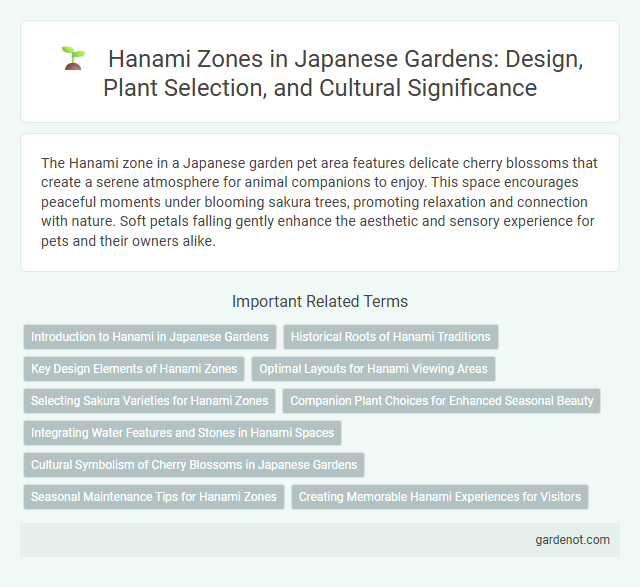The Hanami zone in a Japanese garden pet area features delicate cherry blossoms that create a serene atmosphere for animal companions to enjoy. This space encourages peaceful moments under blooming sakura trees, promoting relaxation and connection with nature. Soft petals falling gently enhance the aesthetic and sensory experience for pets and their owners alike.
Introduction to Hanami in Japanese Gardens
Hanami, the traditional Japanese practice of flower viewing, centers around appreciating the transient beauty of cherry blossoms in designated Hanami zones within Japanese gardens. These areas are carefully designed with clusters of sakura trees, creating picturesque settings that encourage gatherings and seasonal celebrations. The Hanami experience embodies cultural values of mindfulness and the fleeting nature of life, deeply rooted in Japan's historical and aesthetic landscape.
Historical Roots of Hanami Traditions
The Hanami zone in Japanese gardens embodies centuries-old traditions dating back to the Heian period (794-1185), where aristocrats celebrated the transient beauty of cherry blossoms. This cultural practice reflects Japan's deep appreciation for nature's impermanence, intertwined with Buddhist concepts of mono no aware, or bittersweet awareness of ephemerality. Hanami festivals continue to be a significant cultural event, symbolizing renewal and the passage of seasons through immersive floral viewing experiences.
Key Design Elements of Hanami Zones
Hanami zones feature carefully curated cherry blossom trees, creating a stunning floral canopy that highlights seasonal beauty and fosters tranquility. Stone pathways and traditional wooden benches integrate seamlessly into the natural landscape, encouraging leisurely viewing and reflection. Water features such as small ponds or streams enhance sensory experiences, emphasizing harmony and the ephemeral nature of blossoms.
Optimal Layouts for Hanami Viewing Areas
Optimal layouts for Hanami viewing areas emphasize unobstructed sightlines to blooming cherry blossoms, incorporating curved paths and tiered seating to enhance the immersive experience. Incorporation of natural elements such as gentle slopes, water features, and strategically placed benches encourages relaxation and social interaction while maintaining harmony with the garden's aesthetic. Thoughtful spatial planning ensures crowd flow management, preventing congestion during peak blooming periods and preserving the serenity of the Hanami zone.
Selecting Sakura Varieties for Hanami Zones
Selecting optimal sakura varieties for Hanami zones enhances seasonal bloom diversity and extends viewing periods, featuring iconic types such as Somei Yoshino, Shidarezakura, and Yamazakura. Incorporating early, mid, and late-blooming cultivars supports prolonged festivity and balanced aesthetics in traditional Japanese garden design. Careful consideration of tree growth habits, bloom color, and local climate ensures sustainable beauty and cultural authenticity in sakura displays.
Companion Plant Choices for Enhanced Seasonal Beauty
Companion plant choices in a Hanami zone emphasize cherry blossoms paired with azaleas, camellias, and Japanese maples to create layered seasonal colors and textures. Incorporating early-blooming plants like witch hazel and hellebores enhances spring viewing by extending the floral display before and after sakura peak bloom. Understory plantings using ferns, mosses, and shade-tolerant perennials contribute to a tranquil atmosphere, highlighting the delicate beauty of flowering trees while maintaining traditional Japanese garden aesthetics.
Integrating Water Features and Stones in Hanami Spaces
Water features and stones play a crucial role in enhancing the tranquility of Hanami zones within Japanese gardens. Natural stone arrangements alongside gentle streams or koi ponds create harmonious focal points that reflect traditional aesthetics while fostering peaceful contemplation. Incorporating flowing water and textured rocks balances sensory elements, inviting visitors to connect deeply with nature during cherry blossom viewing.
Cultural Symbolism of Cherry Blossoms in Japanese Gardens
Cherry blossoms in the Hanami zone symbolize the transient beauty and ephemeral nature of life, deeply rooted in Japanese cultural and spiritual traditions. These blossoms represent renewal, the fleeting passage of time, and the celebration of mortality, often inspiring poetry and art within Japanese gardens. Their presence enhances the contemplative atmosphere, fostering reflection and harmony between humanity and nature.
Seasonal Maintenance Tips for Hanami Zones
Seasonal maintenance in Hanami zones is essential to preserve the vibrant cherry blossoms and overall garden health, involving regular pruning of sakura trees in late winter to promote healthy growth. Proper soil conditioning with organic compost ensures nutrient-rich grounds, while timely removal of fallen petals and debris prevents fungal diseases. Monitoring water drainage during the rainy season mitigates root rot, supporting the longevity and aesthetic appeal of the Hanami experience.
Creating Memorable Hanami Experiences for Visitors
The Hanami zone in Japanese gardens offers carefully manicured cherry blossom trees that bloom spectacularly each spring, creating an enchanting atmosphere for visitors. Traditional seating areas and peaceful pathways allow guests to fully immerse in the fleeting beauty of sakura petals, fostering serene moments of reflection and connection. Seasonal hanami festivals with cultural performances and tea ceremonies further enrich the visitor experience, making the Hanami zone a cherished destination for appreciating nature and Japanese heritage.
Hanami zone Infographic

 gardenot.com
gardenot.com